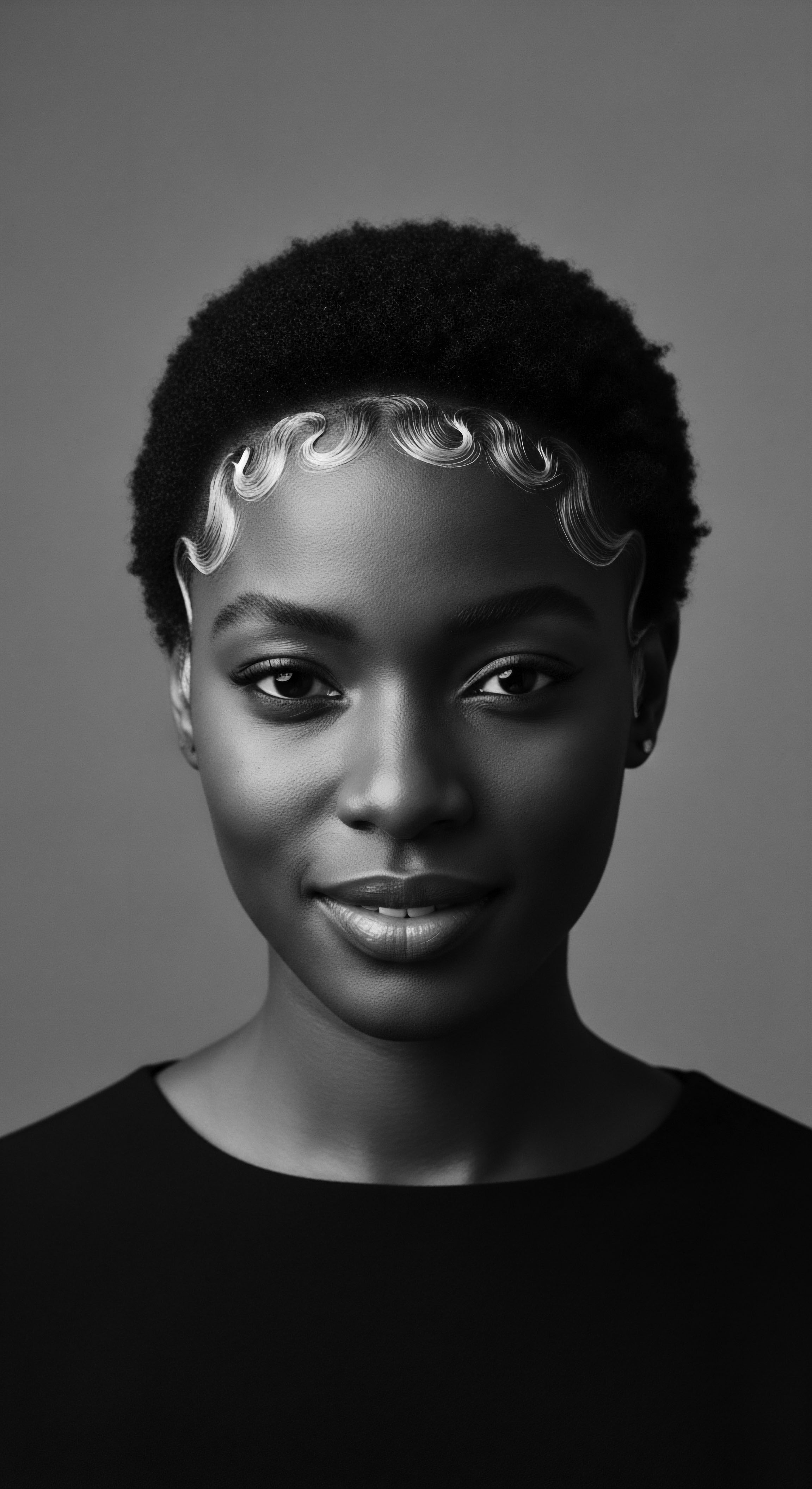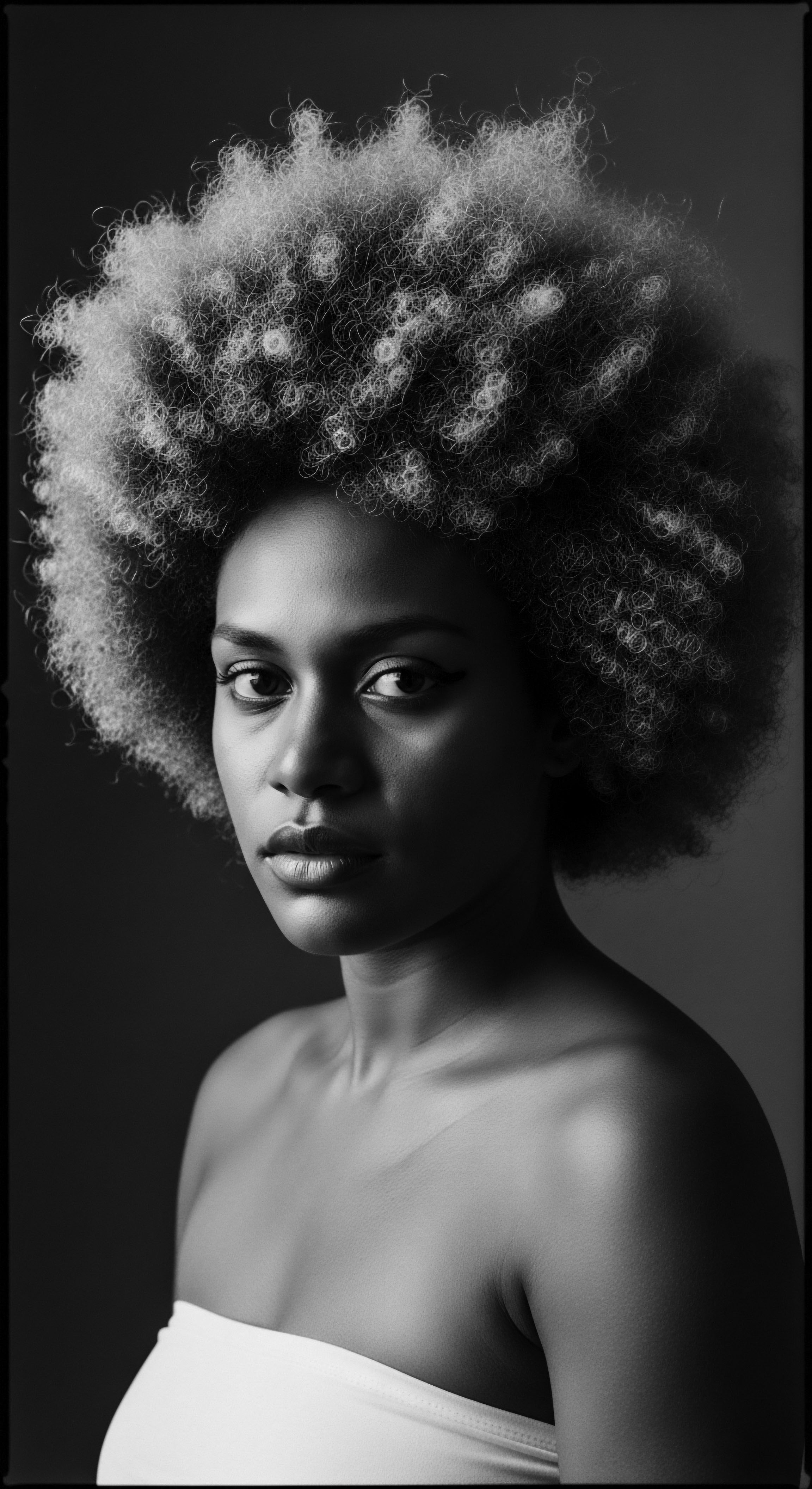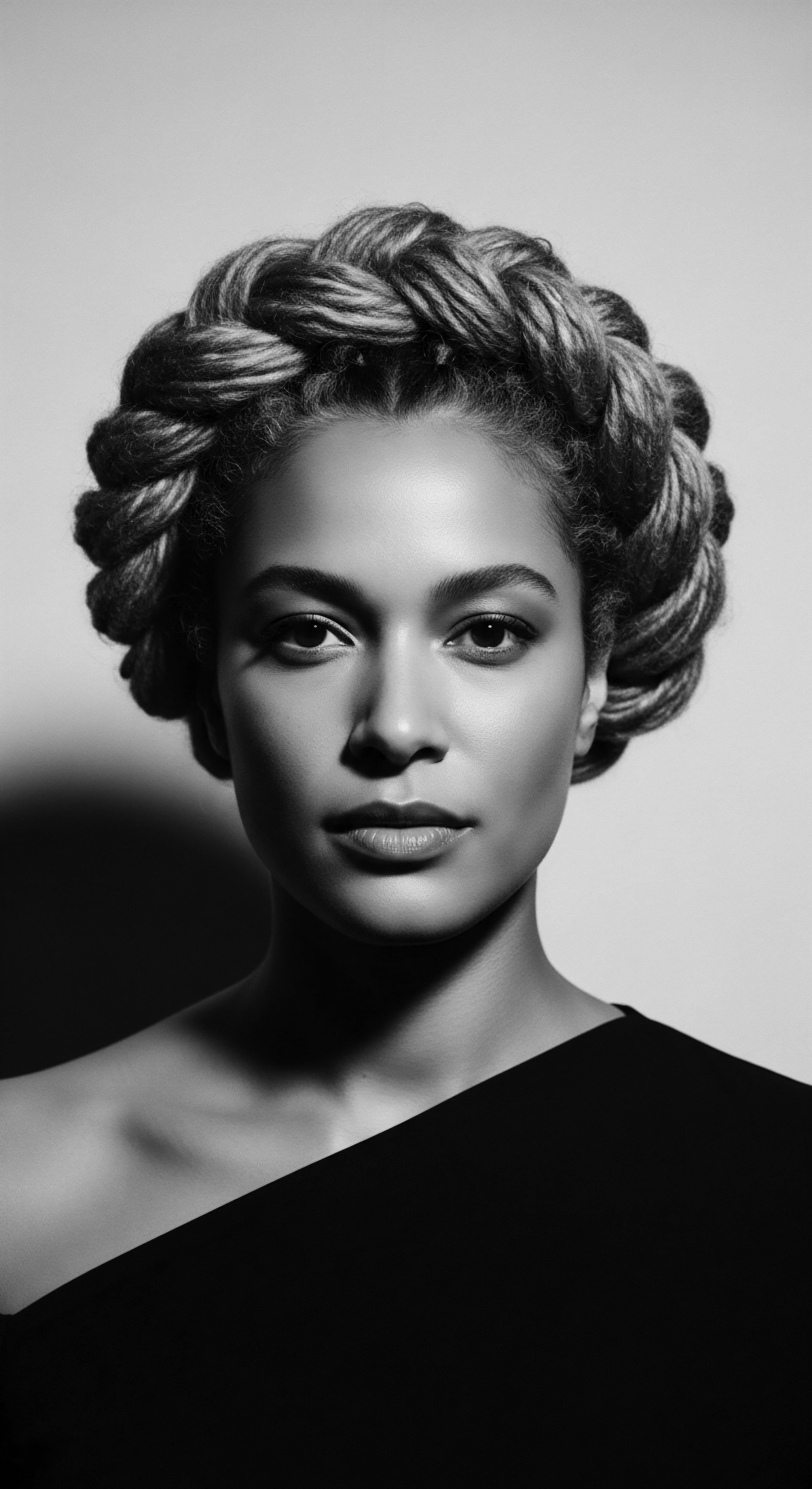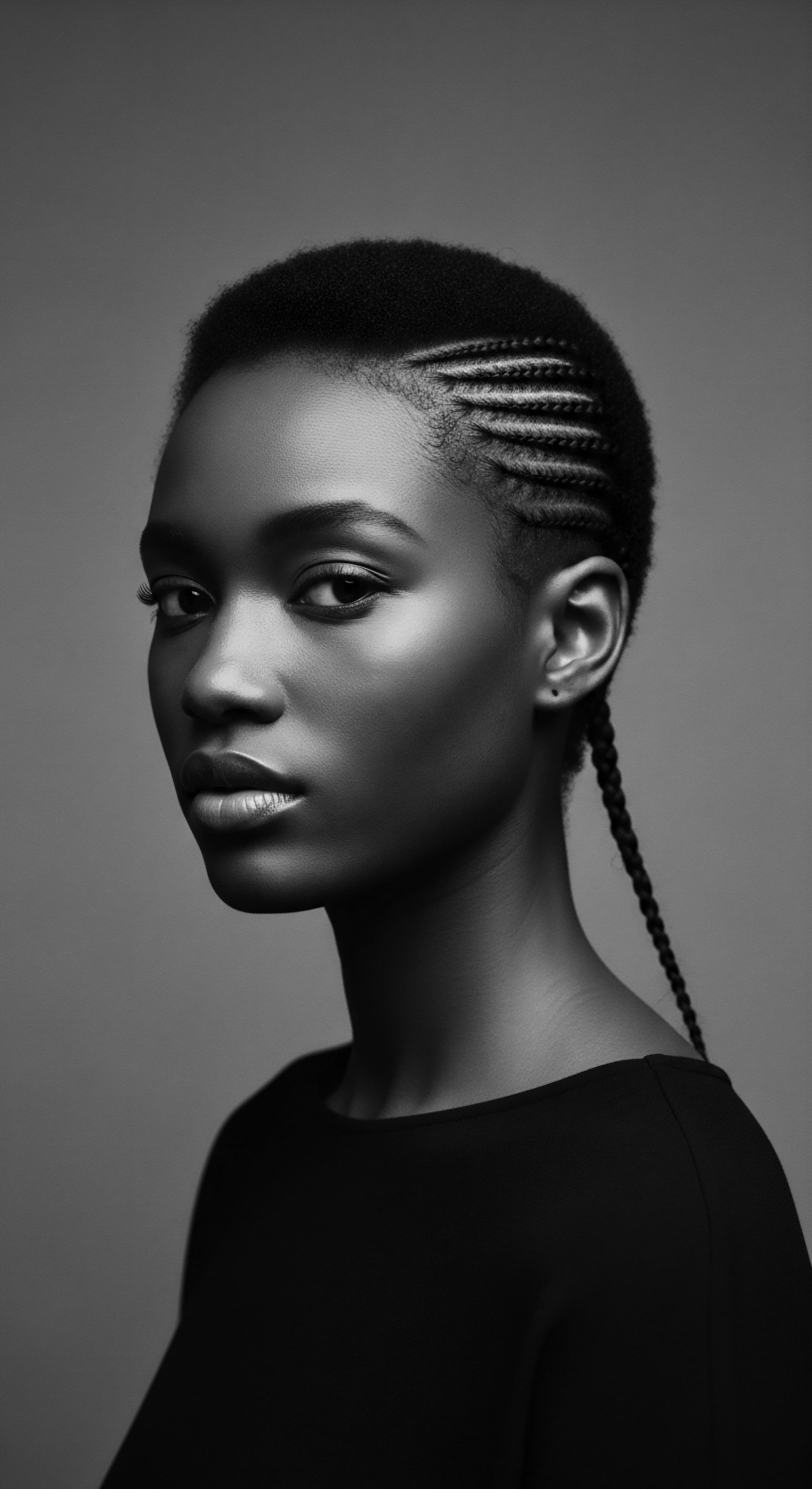
Roots
The stories held within each curl, each coil, each wave of textured hair, run deeper than mere aesthetics. They carry the whispers of ancestors, the resilience of generations, and a profound connection to earth and healing. For countless millennia, across the rich tapestries of African lands and the dispersed pathways of the diaspora, hair has served as more than adornment; it has been a sacred conduit for identity, spiritual expression, and communal bonds. The traditional practice of anointing hair with natural oils stands as a testament to this enduring heritage, a ritual rooted in both intuitive wisdom and, as we now discover, remarkable molecular understanding.
These ancestral practices, refined over ages, offered profound benefits, keeping hair supple, strong, and radiant long before modern science articulated the precise interactions occurring at a microscopic level. It is a dialogue between ancient knowing and contemporary insight, illuminating how these practices nurtured not just the strands, but the very spirit.

What Components Define The Very Structure Of Textured Hair?
To truly appreciate the benefits oils offer, we must first recognize the unique architecture of textured hair. Its spiraling helix creates points of fragility where the strand bends sharply, making it inherently more susceptible to mechanical damage. Each hair fiber, a complex biological polymer, comprises three primary layers ❉ the outermost Cuticle, a protective shield of overlapping cells; the Cortex, the inner core providing strength and elasticity; and, for many hair types, the central Medulla. The cuticle, often described as scales on a fish, is particularly important for textured hair.
Its lifted nature, inherent to the curl pattern, means that the internal structure is more exposed, allowing for both greater absorption and greater loss of moisture. This natural conformation presents unique challenges and opportunities for care, inviting substances to interact with its surface in distinct ways. Traditional care rituals, which so often featured the generous application of various plant-derived oils, seem to have instinctively addressed these structural realities.

How Do Oils Interact At A Molecular Scale With Hair?
The profound efficacy of traditional hair oiling is not merely anecdotal; it rests upon a foundation of specific molecular interactions that uphold hair integrity. Oils, composed primarily of triglycerides, are chemical compounds made of a glycerol backbone and three fatty acid chains. The length and saturation of these fatty acid chains dictate how an oil behaves on and within the hair fiber.
Traditional oiling practices, long before molecular chemistry, instinctively leveraged the unique affinity of certain fatty acids for hair proteins.
Consider Coconut Oil, a staple in many ancestral hair traditions, particularly in parts of India and Africa. Its principal fatty acid, lauric acid, possesses a low molecular weight and a straight, linear chain. This distinct molecular geometry allows coconut oil a rare ability ❉ it can penetrate the hair shaft, rather than simply coating its exterior (Rele & Mohile, 2003; Keis et al. 2005).
Once inside the Cortex, lauric acid exhibits a strong affinity for hair proteins, particularly keratin. This interaction helps to fill voids within the hair fiber, effectively reducing the amount of water the hair absorbs and, critically, minimizing protein loss (Rele & Mohile, 2003). By doing so, it acts as an internal support system, bolstering the hair’s intrinsic strength.
Other oils, like those rich in oleic or linoleic acids (found in olive or sunflower oil, for instance), possess larger, more branched molecular structures. While these oils may not penetrate as deeply, they play a vital role by coating the hair surface. This external layer reduces friction between individual strands, which is particularly beneficial for textured hair prone to tangling and breakage during manipulation. It also creates a hydrophobic barrier, meaning it repels water, thereby mitigating a phenomenon known as Hygral Fatigue—the repeated swelling and deswelling of the hair shaft as it absorbs and releases water.
This cyclical stress weakens the hair over time (Yao Secret, 2024; Healthline, 2020). Traditional oiling thus provided a two-fold protection ❉ internal reinforcement and external shielding.
| Oil Type Coconut Oil |
| Key Molecular Characteristics Low molecular weight, linear lauric acid |
| Primary Interaction with Hair Penetrates hair cortex, binds to proteins, reduces protein loss |
| Traditional Benefit Observed Strengthening, damage prevention, reduced breakage |
| Oil Type Shea Butter (as an oil) |
| Key Molecular Characteristics High saturated fatty acid content, various fatty acids (stearic, oleic) |
| Primary Interaction with Hair Surface coating, lipid barrier, fills cuticle gaps |
| Traditional Benefit Observed Moisture sealing, softening, increased flexibility, sun protection |
| Oil Type Palm Oil (Red Palm Oil) |
| Key Molecular Characteristics High beta-carotene, saturated & unsaturated fatty acids |
| Primary Interaction with Hair Surface coating, antioxidant protection, external lubrication |
| Traditional Benefit Observed Luster, environmental shielding, conditioning |
| Oil Type These oils exemplify how ancestral wisdom intuitively harnessed molecular properties for hair health. |

Ritual
For millennia, the meticulous anointing of textured hair with botanicals was not simply a cosmetic act; it was a profound ritual, a testament to the cultural reverence held for hair across African civilizations and within diasporic communities. These practices, passed through generations, were deeply interwoven with identity, communal life, and spiritual connection. The application of oils was often part of elaborate ceremonies, serving as a protective embrace for styles that conveyed status, age, marital standing, or tribal affiliation. The very essence of these ancestral rituals speaks to an intuitive science, a deep understanding of what the strands truly needed to survive and flourish amidst diverse climates and daily demands.

What Is The Role Of Oils In Protective Styling Heritage?
Protective styles, from intricate braids and twists to artful wraps, have been cornerstones of textured hair heritage for centuries. These styles shield the hair from environmental stresses and daily manipulation, minimizing breakage and promoting length retention. Oils have always played a central supporting role in these practices.
Before braiding or twisting, the hair was, and still is, often saturated with nourishing oils. This process of pre-oiling or “lubricating” the hair shaft reduces friction between strands and the tools used, preventing mechanical damage during the styling process.
Ancestral hands knew how to prepare hair for resilience, coating it with nature’s protection before skilled artistry.
Beyond simple lubrication, the molecular action of these oils, particularly those that penetrate the hair fiber, helps to fortify the hair from within before it is tightly styled or manipulated. This internal reinforcement is critical for hair that will remain in a style for extended periods. Moreover, the hydrophobic barrier created by the oil helps to seal moisture into the hair, a crucial factor for textured hair which, due to its unique structure, can dry out quickly. This sealing action maintains the hair’s pliability and reduces its susceptibility to brittleness.

How Did Ancestral Communities Create And Use Their Hair Oils?
The creation of traditional hair oils was often a communal affair, a legacy of knowledge preserved through oral traditions and hands-on teaching. Take the example of Shea Butter (Vitellaria paradoxa), a vital product across West Africa. Its harvesting and processing into butter involves a multi-step process, traditionally carried out by women, reflecting not just economic activity but also deep cultural significance. The nuts are collected, crushed, roasted, ground into a paste, and then kneaded with water to separate the butter.
This labor-intensive process yields a rich, emollient butter, often infused with other local botanicals for added benefits. Historical records, such as those documenting the travels of Mungo Park in the late 18th century, already noted the widespread importance of shea butter in regions like Mali for food, medicine, and cosmetics (Park, 1799, as referenced in Gallagher, 2016). Recent archaeological findings at Kirikongo in Burkina Faso indicate the use of shea nuts for processing butter dates back to at least 100 CE, pushing back previous assumptions by over a thousand years (Gallagher, 2016). This deep historical lineage underscores the central role of shea in the hair care practices of these communities.
Another powerful example is Red Palm Oil (Elaeis guineensis). In West and Central Africa, where the oil palm tree is often revered as the “tree of life,” red palm oil has been used for over 5,000 years for culinary, medicinal, and cosmetic purposes (GRAIN, 2014; New Directions Aromatics, 2017). This vibrant, nutrient-rich oil, obtained from the fruit pulp, is prized for its high beta-carotene content, a precursor to Vitamin A, which provides potent antioxidant properties.
When applied to hair, its molecular components offer external protection against environmental aggressors, while also lending a distinctive sheen. The process of extracting red palm oil traditionally involved boiling and pressing the fruit, a practice often undertaken by women, contributing to local economies and affirming a deep connection to ancestral lands and resources.
Traditional oil preparation methods varied by region and ingredient, but often shared common principles:
- Harvesting ❉ Gathering nuts, seeds, or fruits (e.g. shea nuts, palm kernels) from indigenous trees, often a community activity, especially for women.
- Processing ❉ Methods such as boiling, crushing, grinding, or fermenting to extract the raw oil or butter. These processes often purified the oil and sometimes enhanced its properties.
- Infusion ❉ Many communities added local herbs, roots, or flowers to the oils. For example, some traditions might infuse oils with rosemary or nettle for scalp stimulation, reflecting a deep botanical knowledge and an understanding of synergies between ingredients.
- Storage ❉ Storing the prepared oils in calabashes, clay pots, or gourds, ensuring their preservation for future use, demonstrating foresight and resourcefulness.

Relay
The enduring legacy of oil-based hair care, passed from elder to youth, serves as a powerful relay of wisdom across generations. These practices, once solely guided by intuition and observed results, now find resonance with modern scientific understanding, bridging the chasm between ancestral knowledge and contemporary molecular biology. This continuous thread of care highlights how traditional regimens provided comprehensive solutions, often addressing a spectrum of hair needs that we still grapple with today. The depth of understanding embedded within these rituals is truly remarkable, revealing a holistic approach to wellbeing where hair health connects to broader life rhythms.

How Do Oils Contribute To Hair’s Hydrophobicity And Resilience?
Hair, particularly textured hair, has a natural inclination to absorb water, which can lead to swelling. While hydration is vital, excessive or repeated swelling and deswelling can damage the hair fiber, leading to what is termed hygral fatigue. This stress weakens the hair’s internal structure and compromises its external protective layers (Healthline, 2020). Oils play a significant role in mitigating this.
By forming a hydrophobic film on the hair’s surface, they reduce the rate at which water enters and leaves the hair shaft. This surface coating, though it might not always penetrate deeply, is instrumental in maintaining the hair’s water balance. The more saturated fatty acids in oils such as Coconut Oil or Shea Butter aid in this process by resisting water molecules more effectively.
The molecular barrier formed by certain oils safeguards hair from the osmotic stresses of water, preserving its strength through ancestral wisdom.
This interaction helps to keep the cuticle scales lying flatter, leading to smoother hair and reducing the likelihood of tangling and snagging. It prevents excessive swelling, thereby preserving the hair’s elasticity and reducing its vulnerability to breakage, particularly for highly porous textured hair which has more lifted cuticles (NYSCC, 2020). The consistent use of oils in traditional routines effectively provided a protective sheath, allowing hair to endure environmental factors and mechanical handling with greater resilience. This protective film also reflects light, giving hair a healthy sheen, a universally recognized sign of vitality.

How Do Oils Replenish Hair’s Natural Lipids?
The hair fiber contains its own natural lipids, both on its surface (exogenous, from sebum) and within its structure (endogenous, such as 18-methyleicosanoic acid or 18-MEA) (Csuka, 2022; MDPI, 2023). These lipids are essential for maintaining the integrity of the cuticle and for imparting the hair’s natural hydrophobicity, acting as a crucial barrier against external damage and internal moisture loss (MDPI, 2023; Healthline, 2020).
However, daily activities, environmental exposure, and cleansing routines can strip these vital lipids away. This lipid loss leaves the hair vulnerable, making it more prone to dryness, frizz, and breakage. This is where the application of traditional oils becomes profoundly significant. Oils, as a source of external lipids, can replenish those lost from the hair surface and, in the case of penetrating oils, partially restore internal lipid deficiencies.
The replenishment process occurs through several molecular mechanisms:
- Surface Adsorption ❉ Many oils, regardless of their penetration ability, adsorb onto the cuticle surface. They fill the microscopic gaps between lifted cuticle cells, smoothing the hair surface and re-establishing a continuous lipid layer. This re-establishes the hair’s primary defense against water absorption and mechanical abrasion.
- Lipid Exchange ❉ The fatty acids present in the applied oils can interact with the natural lipids of the hair, potentially helping to stabilize the existing lipid matrix or replace degraded components. This is especially relevant for maintaining the integrity of the cell membrane complex (CMC), which acts as the intercellular cement binding cuticle cells and cortex together (MDPI, 2024).
- Hydrophobic Interactions ❉ The non-polar (hydrophobic) tails of oil molecules interact favorably with the non-polar regions of hair proteins and existing lipids. This creates a more water-repelling surface and internal environment, which is particularly vital for textured hair that often has a naturally more porous structure.
This molecular replenishment, whether through deep penetration or surface coating, mimics and reinforces the hair’s natural protective mechanisms. For ancestral communities who relied on natural resources for well-being, the consistent application of oils would have intuitively provided this critical replenishment, maintaining hair health and longevity even without formal scientific terms. The result was hair that felt softer, appeared shinier, and was inherently stronger against the rigors of styling and environmental elements. The tradition of daily or weekly oiling, still practiced in many homes today, therefore represents a scientifically sound strategy for maintaining hair’s intrinsic balance and integrity, a practice steeped in thousands of years of observational wisdom.

Reflection
A single strand of textured hair holds more than keratin and lipids; it holds histories, triumphs, and the unspoken resilience of a people. Through the journey from elemental biology to the living traditions of care, it becomes clear that the profound benefits of oil in textured hair rituals are not merely cosmetic improvements but echoes of a deep ancestral knowing. The molecular ballet of lauric acid finding its way into the hair’s core, or the protective shield of an oil coating its surface, validates the wisdom passed down through generations—a wisdom that understood innate needs long before microscopes revealed them.
This enduring dialogue between the ‘Soul of a Strand’ and the nurturing oils represents a continuous legacy of self-care, cultural affirmation, and strength that continues to shape our understanding of beauty, wellness, and heritage today. It is a living, breathing archive, each strand a testament to the powerful, intertwined narratives of science and tradition.

References
- Rele, A. S. & Mohile, R. B. (2003). Effect of mineral oil, sunflower oil, and coconut oil on prevention of hair damage. Journal of Cosmetic Science, 54(2), 175-192.
- Keis, K. et al. (2005). Investigation of penetration abilities of various oils into human hair fibers. Journal of Oleo Science, 54(10), 553-562.
- Gallagher, D. (2016). Shea nuts and early agriculture in West Africa. Journal of Ethnobiology, 36(1), 1-19.
- Yao Secret. (2024). Hygral Fatigue ❉ What Causes It and How to Fix It.
- Healthline. (2020, November 13). Hygral Fatigue ❉ What Causes It and How to Fix It.
- NYSCC. (2020, November 11). An Overview on Hair Porosity.
- GRAIN. (2014, September 22). Africa ❉ another side of palm oil.
- New Directions Aromatics. (2017, October 5). Red Palm Oil & Palm Kernel Oil – For Hair Care & Skin Care.
- Csuka, D. (2022). A systematic review on the lipid composition of human hair. International Journal of Dermatology, 61(6), 670-678.
- MDPI. (2023, July 19). Hair Lipid Structure ❉ Effect of Surfactants. Cosmetics, 10(4), 107.
- MDPI. (2024, April 21). Impact of Hair Damage on the Penetration Profile of Coconut, Avocado, and Argan Oils into Caucasian Hair Fibers. Cosmetics, 11(2), 65.
